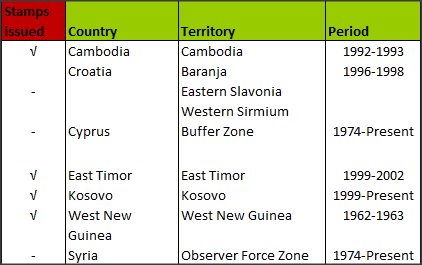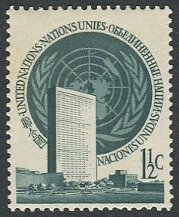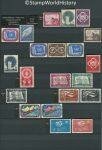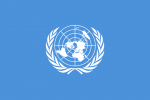
United Nations
Quick reference
General issues: Intergovernmental organization, New York headquarters 1951-Present
Country name on general issues: United Nations
Special issues: Local issue Montreal 1967
Currency: 1 Dollar = 100 Cents
Population: not applicable
Political history United Nations – New York
This profile provides an overview of the United Nations and its activities – not only in New York but worldwide.
Prelude
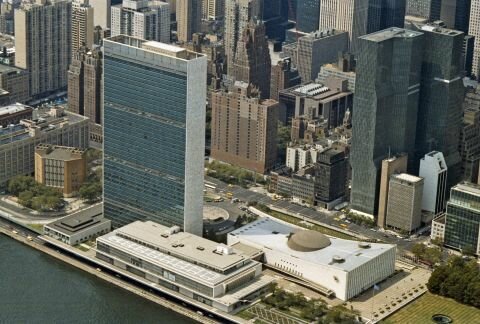
The United Nations headquarters in New York.
WWI shook the world through its scale and intensity. In an attempt to make WWI ‘the war that ended all wars’, the League of Nations was established in 1920. The League of Nations was an intergovernmental organization with the aim to maintain world peace by preventing wars and settling international disputes through negotiation and arbitration. At its greatest extent, the League of Nations counted 58 members. In the 1920’s, the League of Nations mediated in a number of conflicts and established the League of Nations mandated territories – territories administered by members with a mandate of and supervised by the League of Nations. In the 1930’s, the League of Nations proved to be incapable of curtailing the increasing international tensions that eventually led to WWII. Next to its primary goal of maintaining world peace, the League of Nations created platforms for international cooperation on a wide range of subjects such as social and economic development and transports and communication. The League of Nations and the platforms it created were in several ways the precursors to the United Nations and its special agencies.
The United Nations organization
The United Nations was established in 1945 as an intergovernmental organization that promotes international cooperation in three major domains: peacekeeping & security, social & economic development and human rights. In 1945, the United Nations counted 51 founding members. Today membership includes 193 countries – the process of decolonization in the 1960’s and 1970’s being one of the factors that led to the increase. The United Nations System, as it is called, consist of six main organs, eleven funds and programs and sixteen special agencies. The main organs include the General Assembly and the Security Council. Among the funds and programs are UNICEF[1]United Nations Children’s Fund and the UNHCR[2]United Nations High Commissioner for Refugees . The special agencies include the World Bank, the IMF[3]International Monetary Fund , UNESCO[4]United Nations Educational, Scientific and Cultural Organization and the UPU[5]Universal Postal Union . Some of the special agencies – such as the UPU and several organization established by the League of Nations – were founded before the United Nations was established and were incorporated into the United Nations System.
The United Nations has headquarters in New York, Geneva, Vienna and Nairobi. New York is the main seat and, as such, hosts the General Assembly and the Security Council. The special agencies are hosted by a range of countries. The United Nations and its special agencies enjoy extraterritorial rights in their host countries – international law applies to ensure independence and impartiality.
United Nations trust territories
After WWII, one of the main activities of the United Nations, in the domain of peacekeeping and security, was the supervision of the administration of the United Nations trust territories. Trust territories were administered by member states based on a mandate from the United Nations. The primary goal was to guide the trust territories to independence. Most of the trust territories were former League of Nations mandated territories. The United Nations supervised the administration of the trust territories through the United Nations Trusteeship Council – one of the six main organs. The Council was suspended in 1994 when the last trusteeship ended. A summary of the trust territories:
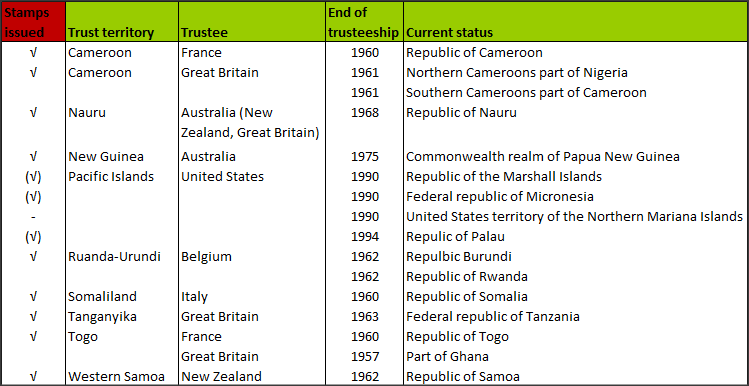
United Nations administered territories and peacekeeping missions
While in the case of trust territories the administration was delegated to member states, the United Nations also administers a number of territories directly. In some cases the United Nations takes responsibility for a transitional government while in other cases the United Nations administer a zone of conflict. A summary of the territories administered by the United Nations:
Finally, in the domain of peacekeeping and security, the United Nations have deployed 55 peacekeeping missions of which 16 are ongoing until the present day.
Postal history United Nations – New York
United Nations – New York
The United Nations has its own stamp issuing policy for its headquarters in New York since 1951. The issues have themes pertaining to the activities of the United Nations. The stamps issued are designed and printed by renowned designers and printers from around the world. A local issue appeared for use in the United Nations pavilion in Expo ’67 in Montreal – issued in the Canadian currency.
United Nations – Worldwide
Stamps are issued by the United Nations proper, but in the broader context of the United Nations’ activities stamps are issued by a range of countries and territories worldwide. An overview:
- Headquarters: As does the United Nations headquarters in New York, the headquarters in Geneva and Vienna have their own stamp issuing policy. In Geneva the United Nations has issued stamps since 1969 and in Vienna since 1979. The headquarters in Nairobi has no stamp issuing policy as of this writing.
- Main organs and special agencies: Aside from the issues by the headquarters, stamps are issued for use by a number of the United Nations main organs and special agencies. While the headquarters are commonly listed as separate stamp issuing entities, the issues for the main organs and special agencies are listed as official stamps issued by the host country. Thus, stamps for United Nations are issued by France – UNESCO, the Netherlands – the International Court of Justice – and Switzerland – the United Nations headquarters until 1969 and the offices for eight of the special agencies. These issues will be discussed in more detail in the future profiles of the respective countries.
- Trust territories: Stamps were issued for all of the United Nations trust territories, with the exception of the Pacific Islands Trust Territory. In the Pacific Islands, stamps of the United States were used. In the advent of independence, Palau started issuing stamps in 1981 and the Marshall Islands and Micronesia in 1981. Please refer to the above table.
- Administered territories: Stamps were issued by United Nations transitional governments in West New Guinea – the former Netherlands New Guinea, Cambodia, East Timor and Kosovo. Please refer to the above table.
- Peacekeeping missions. India issued stamps for its forces deployed on peacekeeping missions in Korea 1953, Cambodia 1954-1962, Laos 1954-1965, Vietnam 1954-1965, Laos & Vietnam 1965-1968, Congo (Kinshasa) 1962 and Egypt 1965.
Finally, probably all countries in the world issue stamps with the United Nations as theme.
Album pages
← Previous page: Turks & Caicos IslandsNext page: United States →

